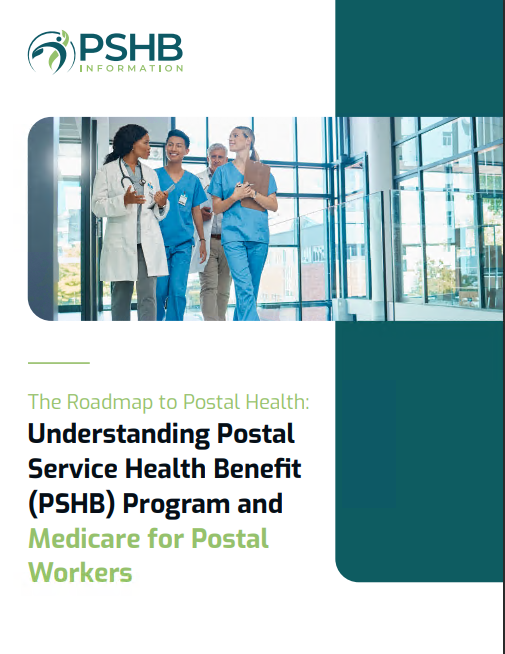Key Takeaways
-
Even with the robust coverage provided by the Postal Service Health Benefits (PSHB) Program, some postal retirees are opting into Medicare Part C for specific reasons that align with their individual priorities.
-
Medicare Part C may offer convenience, additional benefits, or simplified coordination for some retirees—but it doesn’t replace the core role of PSHB and Medicare Parts A and B.
Medicare Part C: A Quick Refresher
Medicare Part C, also called Medicare Advantage, is an alternative way to receive your Medicare benefits. It bundles coverage from Parts A and B and often includes prescription drug coverage and some extras. While PSHB offers strong coverage that works with Original Medicare, Part C plans operate separately, often through private entities.
In 2025, the PSHB program integrates with Medicare for enhanced coordination, especially when both Part A and Part B are in place. Yet, some postal retirees still choose to enroll in Part C—despite already having PSHB coverage. Understanding why can help you decide whether that path fits your needs or not.
1. The Appeal of All-in-One Coverage
One of the main reasons retirees are drawn to Medicare Part C is the convenience factor. These plans can combine hospital, medical, and sometimes drug coverage into one package. For retirees who prefer managing a single plan rather than juggling PSHB alongside Medicare Parts A and B, Part C feels simpler.
However, simplicity doesn’t always mean better. In some cases, using Part C instead of coordinating PSHB with Original Medicare could result in:
-
Limited provider networks
-
Prior authorization requirements
-
Unexpected out-of-pocket expenses
So while the all-in-one appeal is understandable, it may come with trade-offs in access or flexibility.
2. Seeking Additional Non-Medical Perks
Medicare Part C plans often advertise additional services beyond standard medical care. While PSHB plans are comprehensive, they focus primarily on traditional medical coverage. Some retirees are tempted by Part C plans that promote offerings like:
-
Fitness memberships
-
Limited dental or vision extras
-
Wellness incentives
It’s worth noting that many PSHB plans already include vision and dental benefits, and a separate FEDVIP plan can expand those even more. Before you switch or add another plan, compare what you’d gain against what you might lose in terms of coordination and provider access.
3. Living in Regions Where PSHB Plan Networks Are Limited
Although PSHB plans are nationwide, provider networks can vary by area. Some retirees may find their local PSHB network lacks preferred doctors or facilities. In such cases, a retiree might consider a local Medicare Part C plan that better fits their regional needs.
Still, this approach has its downsides. If you leave your service area—say, to visit family in another state—you may face coverage limitations under Part C. PSHB plans generally provide broader national access, which can be a major advantage if you travel frequently or move between locations.
4. Assuming Part C Replaces Part B—Which It Doesn’t
Some retirees mistakenly believe Medicare Part C eliminates the need for Part B. This is not true. Enrolling in Part C still requires you to be enrolled in both Parts A and B. And under PSHB rules in 2025, Medicare-eligible annuitants must keep Part B to maintain full PSHB benefits.
If you skip Part B and opt for Part C thinking it’s a workaround, you could:
-
Incur lifelong late enrollment penalties if you decide to re-enroll later
-
Forfeit eligibility for PSHB coordination
-
Lose access to reduced cost-sharing through PSHB plans
Always verify your eligibility and compliance with PSHB Medicare rules before making enrollment decisions.
5. Misunderstanding the Role of PSHB in Retirement
Some retirees are still unfamiliar with the full benefits of PSHB now that it has replaced FEHB for postal workers. They may believe that Medicare Part C is necessary to cover what PSHB already does. In fact, PSHB plans are designed to work with Medicare A and B to reduce deductibles, out-of-pocket limits, and drug costs.
With integrated coordination, you may receive:
-
Waived or lowered deductibles when you have both Medicare and PSHB
-
Reduced specialist copayments
-
Access to employer-sponsored Medicare Part D drug coverage with a $2,000 out-of-pocket cap
Choosing Part C instead could mean losing these coordination benefits.
6. Preference for Predictable Copays vs. Coinsurance
Some retirees like that certain Medicare Part C plans offer predictable copays for common services. Coinsurance under Original Medicare can feel more variable—especially if you don’t fully understand how your PSHB plan coordinates with it.
While this is a valid concern, PSHB plans that coordinate with Medicare often already reduce or eliminate coinsurance. The key is understanding how your specific PSHB plan integrates with Medicare. Many provide:
-
Lower cost-sharing with Medicare
-
Better coverage with fewer out-of-pocket surprises
-
Stronger protection against catastrophic medical expenses
So if you’re attracted to predictability, don’t overlook what your PSHB plan already offers when paired with Medicare.
7. Believing You Can Keep Both PSHB and Part C
This point causes confusion for many retirees. Technically, you cannot coordinate PSHB with Medicare Part C. If you enroll in a standalone Medicare Advantage plan, it becomes your primary coverage, and PSHB won’t coordinate with it.
This can lead to real issues:
-
You may be paying for a PSHB plan that no longer provides full value
-
You might experience gaps in drug or specialist coverage
-
Some claims could be denied if providers are out-of-network
The 2025 PSHB structure is built around the assumption that eligible retirees will maintain Part A and B—not substitute them with Part C. Always confirm your plan’s rules before enrolling in anything that overrides PSHB coordination.
8. Not Realizing Prescription Drug Coverage May Already Be Included
With the PSHB’s 2025 changes, Medicare-eligible retirees enrolled in a PSHB plan automatically receive prescription drug coverage through a Medicare Part D Employer Group Waiver Plan (EGWP). This means you don’t need a separate drug plan—and adding one could lead to conflicts or disenrollment.
If you enroll in a Part C plan that includes drug coverage, you could:
-
Accidentally cancel your EGWP coverage
-
Lose your PSHB drug benefit entirely
-
Face re-enrollment restrictions later
Coordination of benefits is critical. Before you make changes, be clear on what coverage you’re already getting under PSHB.
When Might Medicare Part C Make Sense for a Postal Retiree?
Despite the risks and trade-offs, some postal retirees still find value in Medicare Part C. It may make sense if:
-
Your PSHB premiums are higher than you prefer, and you’re looking for a lower-cost alternative
-
You have minimal travel needs and your preferred providers are in-network for a local Part C plan
-
You prioritize certain non-medical extras like fitness or transportation
-
You’ve reviewed the fine print and understand how PSHB will be affected by your choice
Just be aware that PSHB coordination ends once Part C becomes your main Medicare coverage. You’ll need to weigh the convenience of Part C against what you may lose in terms of national coverage, cost-sharing reductions, and prescription drug integration.
Make an Informed Choice—Not a Rushed One
Medicare decisions can have lasting consequences, especially under the PSHB structure. The open enrollment period from November to December gives you a chance each year to reassess your choices. Take the time to:
-
Review your current PSHB plan’s coordination with Medicare
-
Compare costs and benefits side-by-side
-
Evaluate how your preferred providers and pharmacies align with either PSHB or Medicare Part C
-
Talk to a licensed insurance agent listed on this website before making a change
Don’t make assumptions about what works best. What you think you’re gaining from Medicare Part C could be something you already have under your PSHB plan—often with better national access, fewer restrictions, and better cost control.
Think Before You Switch—And Get Expert Help
While Medicare Part C has its place for some retirees, it doesn’t always work seamlessly with PSHB. In fact, it can disrupt the coordination you’re entitled to under the new system in 2025. What seems like a benefit may end up reducing your total coverage or increasing your costs.
If you’re considering switching or adding a Medicare plan outside of your PSHB options, make sure you’re doing so with a full understanding of the consequences. Contact a licensed insurance agent listed on this website to go over your plan options and determine what fits your unique healthcare and financial goals.








